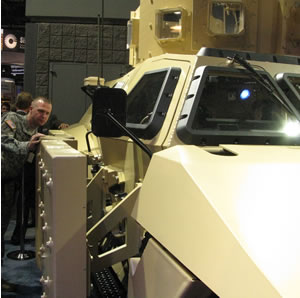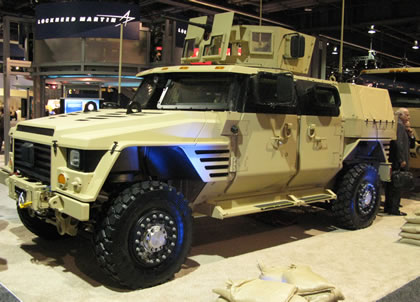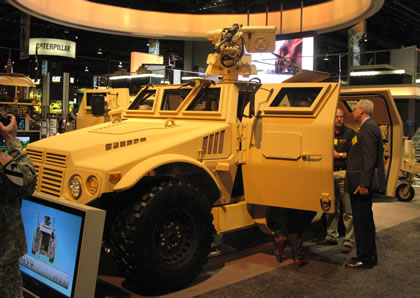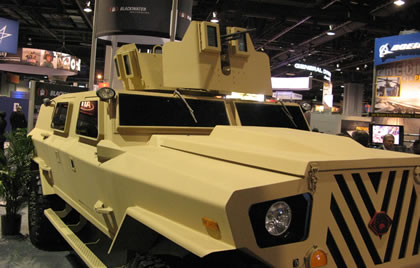The largest wheeled armored vehicle program on the horizon is the Joint Light Tactical Vehicle (JLTV) currently at source selection phase. In the upcoming months the U.S. Army plans to spend some $1.6 billion on the development and production of the new JLTV, including about $315 million for research and development, with the rest going to purchase an initial batch of 1,385 vehicles and 755 trailers. In addition to domestic procurement, the program is expected to receive funding from allies including Australia, the U.K., Israel and Canada. Earlier this month all six teams pitched their products at the Association of US Army exposition in Washington DC, in a last effort to win the services support for their proposals.
On Ocrtober 29 the Army announced the three winners selected for the development program, namely the General Tactical Vehicles group, combining General Dynamics Land Systems and HMMWV maker AM General, the Navistar-BAE Systems team and Lockheed Martin, also teamed with BAE Systems.
At the exhibition some of the teams displayed JLTV concept vehicles being evaluated for the program. Among these companies were Boeing/Textron Systems, General Dynamics/AM General, BAE Systems/Navistar, Lockheed Martin and Blackwater International.
Lockheed Martin unveiled the latest member of its JLTV family candidates – the general purpose “Class A” vehicle configuration. Different from other JLTV variants, this platform is designed with modular add-on rear axle, enabling the vehicle to almost double its payload capacity without significantly increase weight or design complexity. Another candidate for the JLTV program was the vehicle developed by BAE Systems and Navistar. It was publicly introduced at the beginning of the year. The vehicle was displayed here with bulky add-on EFP protection panels, and increased armor, reflecting the more realistic threats expected in the battlefield. The Boeing-Textron Systems team also displayed its contender for the JTLV program. The team highlights the use of a new approach for protection, based primarily on the more ‘threat adaptive’ qualities of the armor solutions provided by hardwire, a member of the Boeing-Textron team. GTV , the joint venture established by GDLS and AM General displayed their approach to JLTV, somewhat larger and more protected version compared to the light ‘concept style’ vehicle displayed earlier. Blackwater’s JLTV candidate was also on display, demonstrating the typical ‘diamond’ shape design.
To date Lockheed Martin built three JLTV demonstrators. The third vehicle was added to the JLTV fleet only recently. The company’ announced its lead vehicle, a ‘Category B’ vehicle demonstrator launched last year has accumulated over 20,000 miles in test drives, mostly in rough off-road terrain. The second vehicle, ‘Category C’ utility vehicle shelter carrier / prime mover variant, launched earlier in 2008 completed about 5,000 miles on test drives sofar. At the AUSA 2008 event Lockheed Martin introduced the general purpose ‘Category A’ 18,250 Gross Vehicle Weight (GVW) vehicle configuration, capable of carrying 3,500 lbs of payload in the fully armored configuration. This vehicle is powered by a Cummins 4.5 liter turbo-diesel coupled to an Allison 2500 transmission. It is capable of maximum speed of 70 mph and cruising range over 400 miles. Meeting the Army and US Marine Corps requirement for JLTV, these vehicles are transportable in C130, CH-47 and CH-53K helicopters and are fully integrated with C4, net-centric operable systems and weapons systems. (At the AUSA exhibition the vehicle was displayed installed with a Gunner Protection Kit (GPK).
 The JLTV developed by BAE Systems and Navistar was publicly introduced at the beginning of the year. The vehicle known as ‘Valanx’ was displayed here with bulky add-on EFP protection panels, and increased armor, reflecting the more realistic threats expected in the battlefield. The Boeing-Textron Systems team also displayed its contender for the JTLV program. The team highlights the use of a new approach for protection, based primarily on the more ‘threat adaptive’ qualities of the armor solutions provided by Hardwire, a member of the Boeing-Textron team. Hardwire combines ultra-hard steel and composites into a compound that presents characteristics specific to the type of threat it is designed to protect from. This approach is claimed to be more affordable and effective, since vehicles are built and fitted for the protection level they are required to meet, rather than stock different modules for different missions. The vehicle uses adjustable, actively stabilized suspension designed to handle rough all-terrain rides with maximum control and minimum crew fatigue. The vehicle is powered by center-located, energy efficient, parallel-Serial hybrid diesel-electric propulsion, offering silent drive and extended silent watch for minimum signature, rapid acceleration. The suspension uses long-travel, ride height etc.
The JLTV developed by BAE Systems and Navistar was publicly introduced at the beginning of the year. The vehicle known as ‘Valanx’ was displayed here with bulky add-on EFP protection panels, and increased armor, reflecting the more realistic threats expected in the battlefield. The Boeing-Textron Systems team also displayed its contender for the JTLV program. The team highlights the use of a new approach for protection, based primarily on the more ‘threat adaptive’ qualities of the armor solutions provided by Hardwire, a member of the Boeing-Textron team. Hardwire combines ultra-hard steel and composites into a compound that presents characteristics specific to the type of threat it is designed to protect from. This approach is claimed to be more affordable and effective, since vehicles are built and fitted for the protection level they are required to meet, rather than stock different modules for different missions. The vehicle uses adjustable, actively stabilized suspension designed to handle rough all-terrain rides with maximum control and minimum crew fatigue. The vehicle is powered by center-located, energy efficient, parallel-Serial hybrid diesel-electric propulsion, offering silent drive and extended silent watch for minimum signature, rapid acceleration. The suspension uses long-travel, ride height etc.
Blackwaters’ proposed JLTV armored vehicle is being developed as part of the Blackwater-Raytheon. This vehicle was displayed for the first time, highlighting Blackwater’s unique diamond shaped counter IED concept pioneered in the Grizzly armored personnel carrier, modified to match the lower silhouette of the JLTV.






















